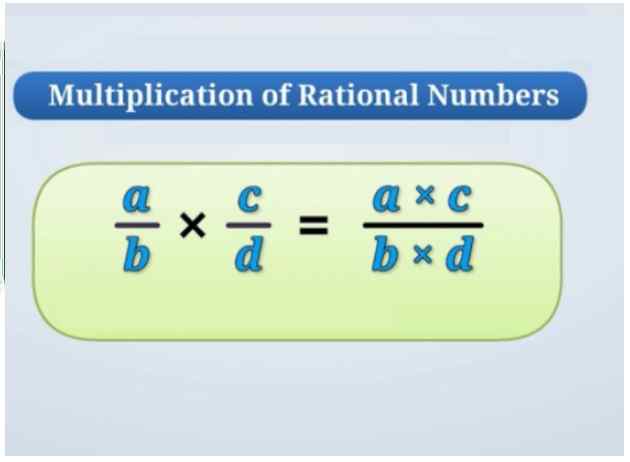Biology Specimen Paper 2023 Sec-B Solved for ICSE Class-10. Step by step solutions as council latest prescribe guideline of Model / Sample Question Paper.

During solutions of Biology Specimen Paper 2023 Sec-B we explain with labelled Figure , Graph, Table, Chart whenever necessary so that student can achieve their goal in next upcoming exam of council. Visit official website CISCE for detail information about ICSE Board Class-10.
Solution of ICSE Biology Specimen Paper 2023 Sec-B for Class-10
| Board | ICSE |
| Class | 10th (x) |
| Subject | Biology |
| Topic | Specimen Paper Solved |
| Syllabus | Revised Syllabus |
| Session | 2022-23 |
| Sec-B | Descriptive Type |
| Max Marks | 80 |
Warning :- Before viewing solution view Question Paper. Also visit that How CISCE Change Same Question in Different Pattern which feel a new one question while it was previous year question . Therefore a Question arise into the mind of student if CISCE Ask Repeated Question in Board Exam..?.
BIOLOGY SPECIMEN QUESTION PAPER SEC-B ICSE 2023 EXAMINATION
Maximum Marks: 80
- Time allowed: Two hours
- Answers to this Paper must be written on the paper provided separately.
- You will not be allowed to write during first 15 minutes.
- This time is to be spent in reading the question paper.
- The time given at the head of this Paper is the time allowed for writing the answers.
- Section A is compulsory. Attempt any four questions from Section B.
- The intended marks for questions or parts of questions are given in brackets [ ].
SECTION B
(Attempt any four questions from this Section.)
Biology Specimen Paper 2023 Sec-B Solved for ICSE Class-10
Question 3:
(i) Define Guttation.
(ii) Give one difference between Lenticels and Stomata.
(iii) What is Parthenocarpy? Give one example.
(iv) State Mendel’s Law of Segregation.
(v) Study the diagram given below and answer the questions that follow:
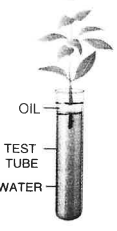
(a) Name process being studied in the above experiment.
(b) What will you observe with regard to the level of water when this setup is placed in bright sunlight.
(c) Mention one adaptation found in plants to overcome the process mentioned in (i).
Answer :
(i) Guttation is the process of secretion of water droplets from the pores of some vascular plants like grass. Guttation is often confused with dew droplets that condense from the atmosphere onto the plant’s surface.
(ii) The main difference between stomata and lenticels is that stomata mainly occur in the lower epidermis of leaves, whereas lenticels occur in the periderm of the woody trunk or stems.
(iii) Parthenocarpy, development of fruit without fertilization. The fruit resembles a normally produced fruit but is seedless. Ex. Pineapple
(iv) Mendel’s law of segregation states that: “During the formation of gamete, each gene separates from each other so that each gamete carries only one allele for each gene.” Law of segregation is the second law of inheritance.
(v) (a) Transpirations
(b) The level of water will power which indicate loss of water by the shoot due to transpiration, because due to oil in the surface, no water loss due to evaporation.
(c) Sunken stomata and narrow leaves in Nerium
Question 4: (Biology Specimen Paper 2023 Sec-B)
(i) Expand the abbreviation — A T P.
(ii) Name any two nitrogenous bases.
(iii) Addition of salt to pickles prevents the growth of bacteria. Explain by giving two suitable reasons.
(iv) Mention two adaptations in leaves to perform Photosynthesis.
(v) Given below is a diagram representing a stage during the mitotic cell division.
Answer the following questions:
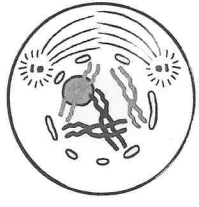
(a) Identify the stage.
(b) Give a suitable reason for your answer in (a).
(c) Name the stage that follows the one shown in the diagram.
Answer :
(i) Adenosine triphosphate
(ii) adenine (A), thymine (T), cytosine (C), and guanine (G).
(iii) Addition of salt to pickles prevents growth of bacteria because they turn flaccid.
Reason: Addition of salt to pickles increases the concentration and when bacterias come in contact it undergoes exosmosis and thus becomes flaccid or plasmolysed leading to its death.
(iv) 1. Large surface area for maximum light absorption.
2. Leaf arrangement at right angle to light source.
(v) (a) Early prophase.
(b) Centriole moving a part, chromosome become a distinct, spindle fiber appear .
(c) After late prophase, next stage is Metaphase.
Question 5:
(i) Define — Excretion.
(ii) What is the significance of Hepatic Portal Vein?
(iii) State two functions of vitreous humour.
(iv) Which gland secretes Glucagon? What is its effect on blood sugar level?
(v) Draw a neat labelled diagram to show the internal structure of a human kidney.
Answer :
(i) Excretion is a process in which metabolic waste is eliminated from an organism. In vertebrates this is primarily carried out by the lungs, kidneys, and skin. This is in contrast with secretion, where the substance may have specific tasks after leaving the cell.
(ii) Significance of Hepatic Portal Vein:
1. The hepatic portal vein carries 75% of the hepatic blood flow and hence is crucial. It is not a true vein as it does not conduct blood directly to the heart.
2. It supplies veins with metabolic substrates.
(iii) 1. It help in keeping the shape of eyeball.
2. it protect the retina and its nerve ending.
(iv) Glucagon is secreted by the alpha cells in pancreases. It raise the sugar level in the blood because it stimulates the breakdown of glycogen of glucose in liver .
(v)
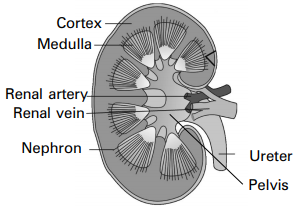
Question 6: (Biology Specimen Paper 2023 Sec-B)
(i) Define — Gene.
(ii) Differentiate between Cell wall and Cell membrane with reference to permeability.
(iii) State the function of Medulla Oblongata with a suitable example.
(iv) Colour blindness is generally seen in males. Explain.
(v) Study the diagram given below and answer the questions that follow:
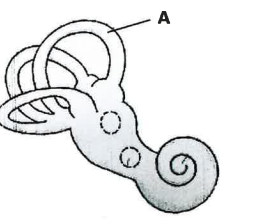
(a) Identify the structure.
(b) In which part of the ear is it located?
(c) What is the function of the part marked A?
Answer :
(i) A gene is a basic unit of heredity and a sequence of nucleotides in DNA that encodes the synthesis of a gene product, either RNA or protein.
(ii) Cell wall is thin and permeable
Cell membrane is very thin and semi-permeable
(iii) To control the activities of internal organs like beating of heart and many others involuntary actions.
(iv) It’s passed down on the X chromosome, red-green color blindness is more common in men. This is because: Males have only 1 X chromosome, from their mother. If that X chromosome has the gene for red-green color blindness (instead of a normal X chromosome), they will have red-green color blindness.
(v)
(a) Part of the human ear.
(b) Inner Part
(c) Semi circular canals- Responds of the change in position, ex. it is concered with the sense of dynamic blance.
Question 7:
(i) Explain — Accommodation of eye.
(ii) Give two reasons for a sharp rise in world human population.
(iii) Mention two functions of Amniotic fluid.
(iv) What is the difference between Phenotype and Genotype?
(v) Draw neat labelled diagrams showing the cross sections of an Artery and a Vein.
Answer :
(i) The process of focusing the eye to see object at different distance is called Accommodation.
(ii) (a) Industrial Revolution (b) New discovery in medical science
(iii) (a) Protects the embryo from physical damage.
(b) Allow the foetus some restricted movement
(iv) Difference between Phenotype and Genotype:
| Genotype | Phenotype |
| The hereditary information of the organism in the form of gene in the DNA and remains the same throughout the life. | The characters of an organism which are visible are known as phenotypes. |
| Same genotype produces same phenotype. | Same phenotype may or may not belong to same genotype. |
| Present inside the body as genetic material. | Expression of genes as the external appearence. |
| The genotype is inherited from the parent to the offspring. | The phenotype is not inherited from the parent. |
(v)
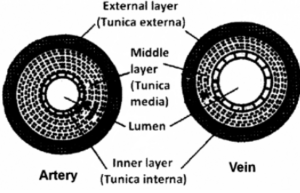
Question 8: (Biology Specimen Paper 2023 Sec-B)
(i) Define — Pollution.
(ii) Plants droop on a hot day even though the soil is well watered. Explain.
(iii) Differentiate between Menarche and Menopause.
(iv) State two harmful effects of acid rain.
(v) The diagram given below shows a type of tropism. Answer the questions that follow:
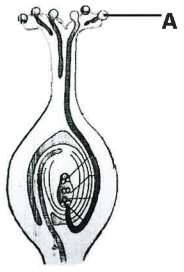
(a) Name the type of tropism.
(b) Define the above mentioned tropism.
(c) Give an example of a stimulant that helps in the growth of the part marked — A.
Answer :
(i) Pollution is the introduction of harmful materials into the environment. These harmful materials are called pollutants. Pollutants can be natural, such as volcanic ash.
(ii) On a hot day, herbaceous plants wilt even in well-watered soil because their rate of transpiration exceeds the rate of water absorption by the roots. Due to less water in the cells, they become flaccid and leaves become soft and wilt.
(iii) Menarche is the first menstruation of the human female on the attainment of puberty that occurs at about 13 years of age, whereas menopause is the phase in the human females life when ovulation and menstruation stop that occurs at about 45-55 years of age.
(iv) Dead or dying trees are a common sight in areas effected by acid rain. Acid rain leaches aluminum from the soil. That aluminum may be harmful to plants as well as animals. Acid rain also removes minerals and nutrients from the soil that trees need to grow.
(v)
(a) Chemotropism
(b) Due to chemicals
(c) A is pollen grain and stimulant is Auxin
Return to : ICSE Specimen Paper 2023 Solved
–: visit also :–
- ICSE Class-10 Textbook Solutions Syllabus Solved Paper Notes
- School will be closed on These Dates in August, Check Total Holidays
- High Salary Top Courses After 12th Science for Boys / Girls
- Which School Board is Better for IIT JEE and NEET Preparation?
- Which Entrance Exam Is Easier To Crack – NEET, IIT, JEE?.
Thanks



